Valais Blacknose is one of the sheep breeds that have earned quite a reputation for being both expensive and high-maintenance, traits that can be intimidating for potential sheep farmers.
The idea of spending a significant amount of money for a single lamb or a sheep and dedicating time and care to their needs might make sheep farmers quit raising them.
But it’s essential to know what to look for when buying a new sheep breed and go beyond the surface. Digging deeper, these sheep have several great qualities that make them a good choice for farming.
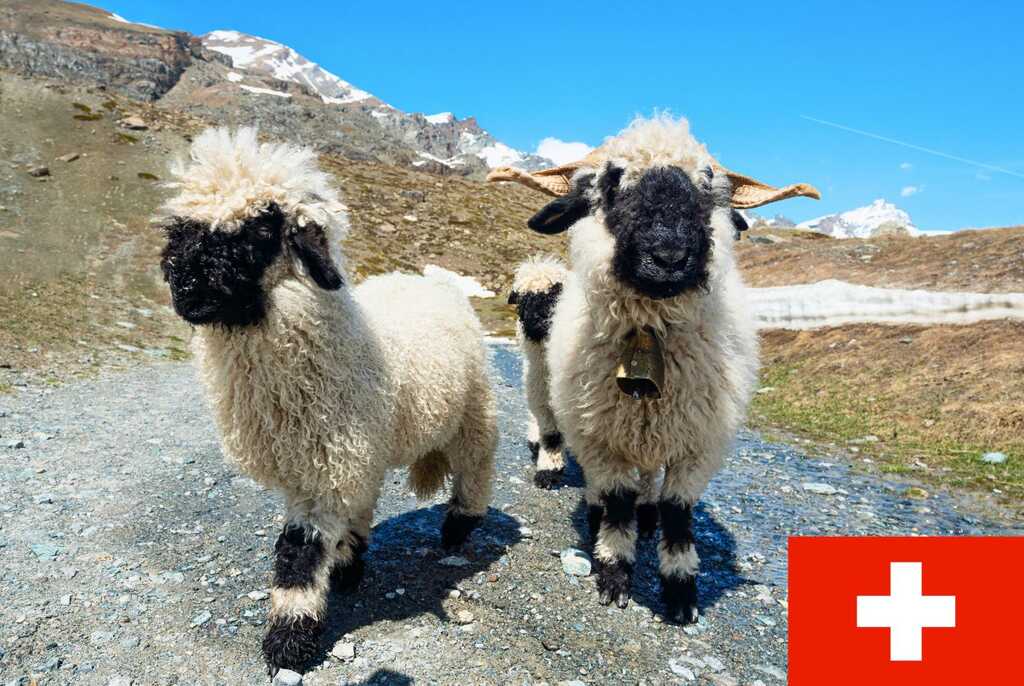
Contents
Short summary
| Good for: | homesteaders and small farms |
| Type: | dual-purpose |
| Size: | medium size |
| Color: | white and black |
| Fleece: | lambs: 28 to 30 micrometers, adult male: 38 micrometers |
| Lifespan: | 10 to 12 years |
| Growth Rate: | grow slowly, 2 years for the final weight |
| Weight: | ewe: 50 and 200 lbs (70-90kg), ram: 180 to 290 lbs (80-130kg) |
| Sexual maturity: | 18 to 24 months |
| Slaughtered age: | 1 to 1.5 years of age |
| Litter size: | 1-2 lambs per year |
| Price: | $5.000 and $6.000 for a sheep and $15.000 and $17.000 for a lamb |
| Wool price: | $6.00 for 1.5 oz |
| Frozen embryo price: | $4.000 to $8.000 |
The Valais Blacknose sheep is a dual-purpose domestic sheep breed that originated in the Valais region, specifically in the mountains of the Canton of Valais, Switzerland.
The origins of Valais Blacknose sheep can be traced back to the fifteenth century but under a different name. These sheep are descendants of ancient breeds that were adapted to the alpine environment over centuries.

Characteristics
The characteristics of sheep are unique within their species, with their most distinctive features being coloration, horns, and wool.
These physical characteristics make them very easy to recognize.
Size
Valais Blacknose sheep has a medium size.
It is bigger than a Jacob sheep but smaller than a Suffolk sheep.
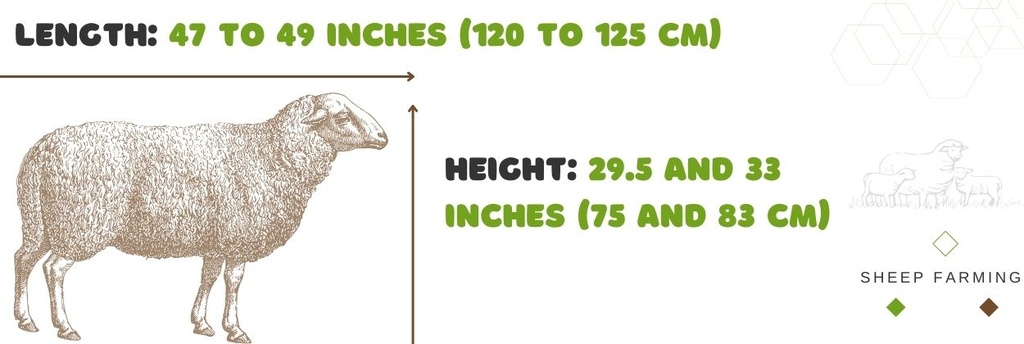
Females have a withers height, which is the highest point of their shoulder, of 28 to 31 inches (72 to 78 cm), while males can measure between 29.5 and 33 inches (75 and 83 cm) by the time they reach two years of age.
Also, the average length of the breed is 47 to 49 inches (120 to 125 cm).
Color
The color of the sheep is white and black.
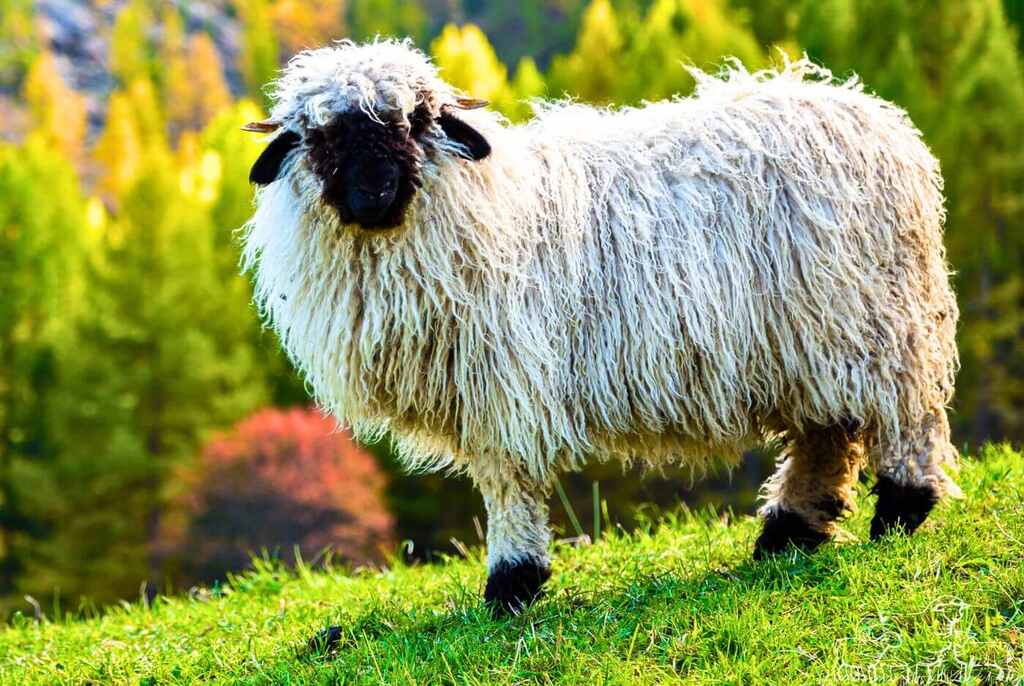
The white and black colors follow a specific pattern, which is also used as a standard for the breed when registering one:
- Black from the nose extending to the center of the head.
- The area around the eyes is black, connecting with the black of the nose without any gap.
- The ears are black, meeting the white of the head.
- Hooves and ankle area are black, resembling “black socks.”
- Knees and hocks have black spots, which can be asymmetrical.
- Females have a black tail spot with a finger-width gap of white on the tail.
- Males do not have a tail spot.
- The male’s scrotum is black, but this color is not spread upward into the belly area and fleece.
Fleece
The fleece is universally white and soft, but as they mature, it becomes coarser.
The staple length of the fleece is a minimum of 4 inches (10 cm) after 6 months of growth, but it can also reach up to 6 inches (15 cm), depending on genetics and nutrition. Over the course of a full year, the fleece can grow to a length of 12 inches (31 cm).
In terms of diameter, the fleece of Valais Blacknose sheep is thinnest for lambs, measuring around 28 to 30 micrometers, while in adult males, it’s thicker, averaging about 38 micrometers.
Sheep have a thicker and fuller fleece on their legs, while on their head, the fleece is natural and long.
Head, Ears, Face, Eyes

The sheep has a short head with a broad forehead, black eyes, and a relatively wide mouth. The lower jaw is short and uneven in length.
The neck is short and well-muscled, while the ears are of medium length and black.
The ears can move independently of each other, meaning that one can be moved without affecting the other.
Horns
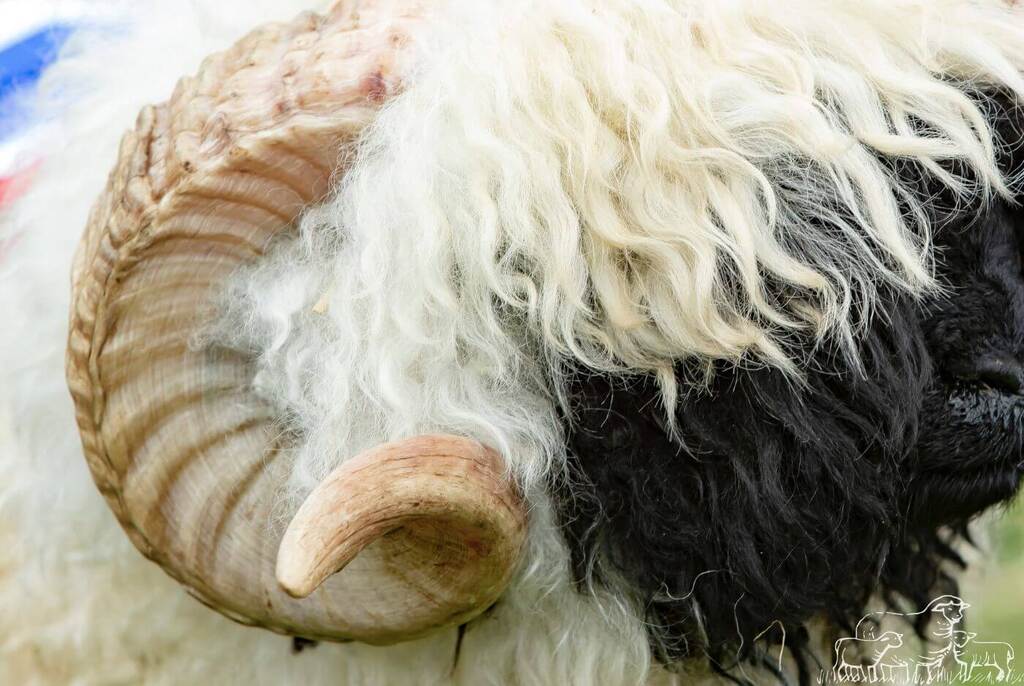
Horns are found in both rams and ewes of the breed.
They are well-separated and spiral outward, running parallel to the jaws.
In some sheep, the horns have black streaks.
Chest, Shoulder, Withers
The chest is noticeably wide and deep, making the sheep look strong.
The shoulder fits well and looks like it’s part of the body.
The withers, where the neck and back meet, have a width that fits nicely and makes the sheep look solid and robust.
Also, the ribs have a clear curve, which adds to the overall appearance of the sheep.
Back and Loin
The back extends nicely, maintaining a long, straight, and notably wide appearance.
This body structure ensures a balanced and steady posture for the sheep.
Also, the loin region stands out for its generous width, which adds to the breed’s inherent strength and presence.
Pelvis, Abdomen & Hindquarters
The abdomen, or belly, is of moderate size and is characterized by small hollows, indicating good health.
The pelvis is wide and medium-length, while the hindquarters have well-developed musculature.
Legs

The legs are sturdy and sure-footed.
Their hooves are solid and positioned well. The legs are not bent outward or inward.
They are not curved like a cow’s horns or shaped like the letter “o.” The front legs are spread wide, but not too much like the letter “x.”
Overall, the legs are strong, steady, and in a good position.
Tail
The tail is long, straight, and covered with wool.
Lifespan
Valais Blacknose sheep can live for 10 to 12 years.
Growth Rate
How fast do these sheep grow?
Valais Blacknose sheep grow slowly, reaching their final weight by the age of 2 years.
They achieve sexual maturity a bit earlier, around 18 to 24 months.
It is recommended not to breed these sheep until they are over 12 months old. Before this age, they may not be physically mature enough to handle pregnancy and labor.
Weight
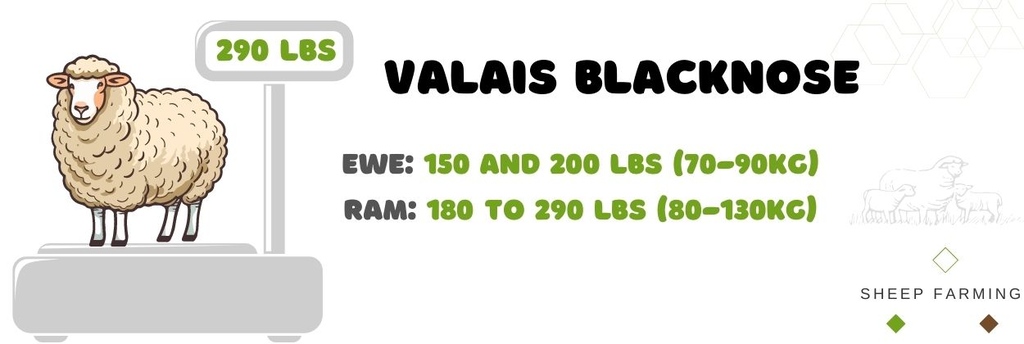
A ewe weighs between 150 and 200 lbs (70-90kg).
A ram reaches a weight of 180 to 290 lbs (80-130kg).
Slaughtered age
You can slaughter a Valais Blacknose sheep at around 1 to 1.5 years of age.
Shearing
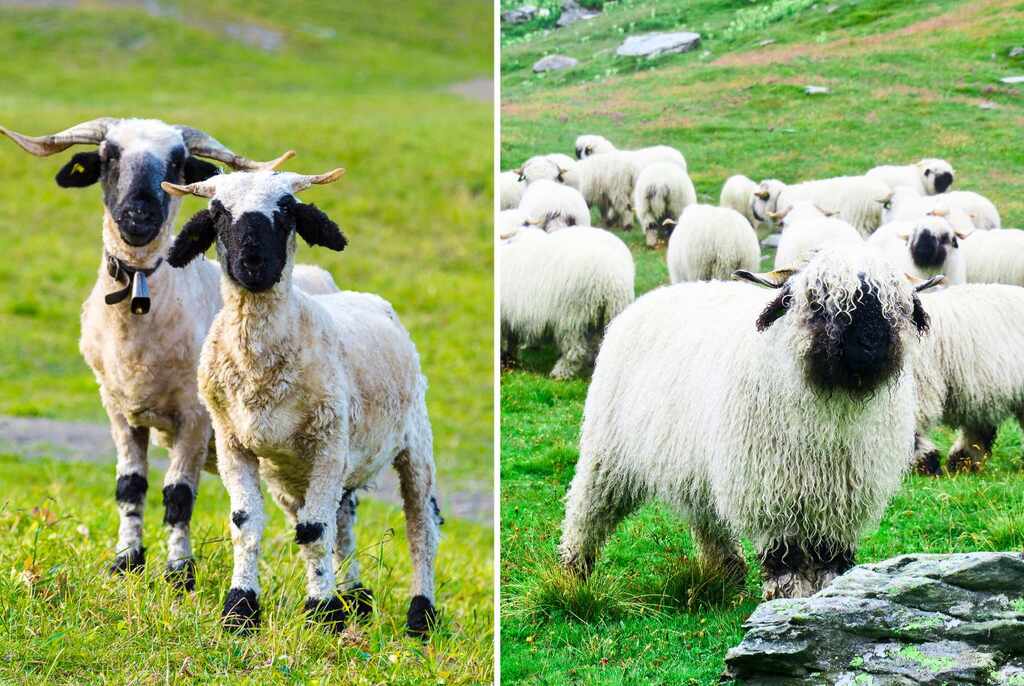
Sheep are sheared twice a year.
Shearing timing, as with many sheep breeds, depends on several factors, including climate, region, and the intended use of the wool.
In Switzerland, farmers shear these sheep in October and February.
You can also choose to shear lambs in September of the year they are born, and then again in March to allow their wool to grow enough length for showing.
No matter when you do it, remember that it is essential to shear sheep every six months.
Here are some tips to consider when shearing a sheep:
1.
If the sheep were housed over the winter, it is recommended to wash them 3-4 days before shearing.
Also, if you want to obtain very clean wool from these sheep, it is recommended to wash them. Some sheep farmers use tubs with warm water and special products like non-bio detergent to wash them.
Washing them helps remove all the dirt accumulated in their wool and all the lanolin.
After their bath, you can use your fingers or a wide comb to untangle their locks.
Remember, it is not recommended to brush their wool when it’s dry.
2.
Shearing Valais Blacknose sheep is different from shearing commercial sheep like Merino Dorper or Katahdin.
3.
You must shear the sheep in a clean environment and use clean tools to prevent the fleece from getting dirty.
4.
Take your time when shearing around the sheep’s horns, hooves, and their rear ends.
5.
After finishing, handle the wool carefully to avoid damage and contamination.
Facts:
1.
If a breeder has a small number of sheep in their flock, there may be no necessity to mark them as commercial sheep.
This is particularly significant because markings on the sheep’s wool are hard to remove and significantly reduce the wool’s value.
If marking is required, especially when planning to sell the fleece at a higher price, it’s advisable to mark the sheep on the back of their head rather than on their back.
2.
Avoid touching the sheep’s horns until they reach 12 months of age. They are fragile and can break easily.
Temperament and Behaviour
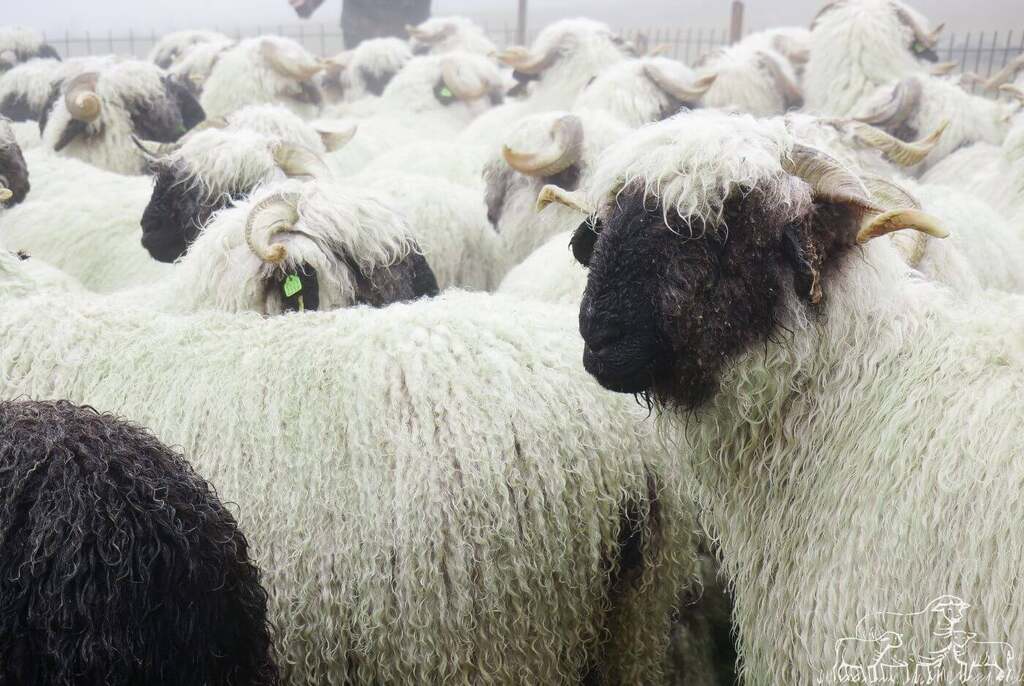
Valais Blacknose sheep are friendly, calm, and docile.
These domesticated sheep are very easy to handle and work with, as they are not afraid or shy when it comes to human contact. They are comfortable with interacting with people and are also quite obedient.
They are sociable animals and love living in a herd. They can learn easy commands due to their relatively high intelligence.
Another great aspect of these sheep is that they are not as active or excitable as other sheep breeds. They prefer to enjoy their time in nature without running around, jumping, or playing.
Usage
Valais Blacknose sheep are used for meat and wool.
Meat
The meat is truly distinctive from other sheep meats.
What makes it truly unique is the fact that even though it is sheep meat, it does not taste or smell like regular sheep meat when cooked.
This distinction can be attributed to their special diet, which includes a variety of mountain herbs.
This quality makes it an excellent choice even for those who are not fans of sheep meat and for chefs around the world.
In addition to its mild and delicate flavor, the meat is lean and tender, making it ideal for various culinary dishes.
This meat is famous for having less fat, with about half the fat of other sheep breeds. The lower fat content also gives the meat a slight marbling, which makes it more tender.
It provides a good amount of protein, as well as essential amino acids, vitamins, and minerals.
Wool
Valais Blacknose sheep are primarily valued for their wool production, as they have the capacity to yield a substantial quantity of wool.
Every six months, lambs can produce 2.2-3.3 lbs (1-1.5 kg) of wool, while ewes and rams can produce 5.5-6.5 lbs (2.5-3 kg) each.
| 6 months | 1 year | |
|---|---|---|
| Lamb | 2.2 – 3.3 lbs (1 – 1.5 kg) |
4.4 – 6.6 lbs (2 – 3 kg) |
| Ewe | 5.5 – 6.6 lbs (2.5 – 3 kg) |
11 – 13.2 lbs (5 – 6 kg) |
| Ram | 5.5 – 6.6 lbs (2.5 – 3 kg) |
11 – 13.2 lbs (5 – 6 kg) |
The wool is distributed uniformly across their body, covering their face and legs, while maintaining consistent characteristics and thickness.
Also, the wool’s texture evolves from birth to maturity.
Regarding its usage, although often recognized for its suitability in carpet-making, felting, and stuffing mattresses, the wool can also be blended with finer wool to create a softer fiber.
Raising this Breed

Raising Valais Blacknose sheep involves various aspects, including providing them with a proper diet that fulfills their nutritional requirements for healthy growth, ensuring a suitable shelter, a continuous supply of fresh water, and more.
Feeding
You can feed them with grass, mountain herbs, hay, nuts, and vegetables.
The primary sources of food for these sheep are grass and mountain herbs.
These sheep can graze for up to 8 hours per day.
During seasons with high-quality grass, you can choose not to supplement their diet with other hard foods unless you want to. If there’s sufficient grass and a reasonable number of sheep per acre, each sheep will typically consume enough grass to sustain itself.
If you opt to supplement their diet for various reasons, you can provide nuts, which are among the highest-quality foods they can receive.
You can offer them 1.1 – 1.6 lbs (0.5 – 0.75 kg) of nuts per sheep per day.
For lambs aged 2 weeks to 5 months, introduce lamb creep hard food. After this period, switch female lambs to ewe nuts and male lambs to a ram coarse mix.
Always ensure that ram lambs do not eat ewe nuts.
You can also provide hay.
A sheep can consume between 2.2 – 6.6 lbs (1-3 kg) of grains per day. During cold seasons when grass isn’t available, you can feed them hay exclusively.
The quantity of concentrate feed needed depends on the available forage quantity and quality, the time before lambing, and the number of lambs.
In addition to feed, these sheep require a constant source of fresh water at all times. Also, it’s suggested to have a quality vitamin lick accessible for the sheep continuously.
How many sheep per acre?
You can raise 6 to 10 Valais Blacknose sheep per acre.
This depends on factors such as climate, grass quality, and topography.
Environment
The right environment for these sheep is an alpine or mountainous setting.
They thrive in environments characterized by rugged terrain, high altitudes, and pastures. But with the right accommodations and requirements, these sheep can adapt to new types of environments.
Climate
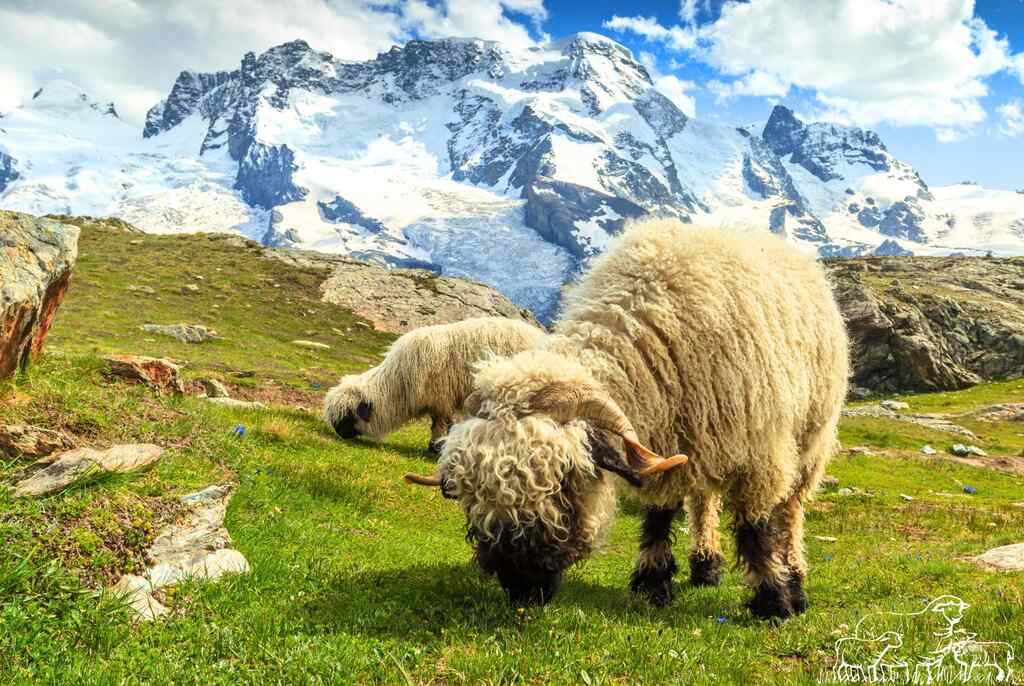
The right climate for Valais Blacknose sheep is the alpine climate, which is characterized by cold winters with heavy snowfall and cool summers.
The sheep’s thick, woolly coat provides excellent insulation against the cold temperatures, allowing them to withstand the harsh winter conditions.
If introduced to areas with different climates, it’s important to ensure that they have access to shelter and an appropriate diet.
Shelter
These sheep need shelter, especially in regions with extreme weather conditions.
While they are well-suited for outdoor grazing, providing a proper shelter with appropriate bedding is essential to protect them from heavy rain, snowstorms, extreme cold temperatures, or heat, depending on the region.
The shelter offers them shade during the summer and keeps them warm during severe weather conditions, preventing health issues such as frostbite or hypothermia.
These sheep also require a sturdy fence to keep predators like wolves, foxes, and other animals at bay.
Fencing is particularly critical during the lambing season, as it provides a secure area for pregnant ewes and newborn lambs.
Breeding
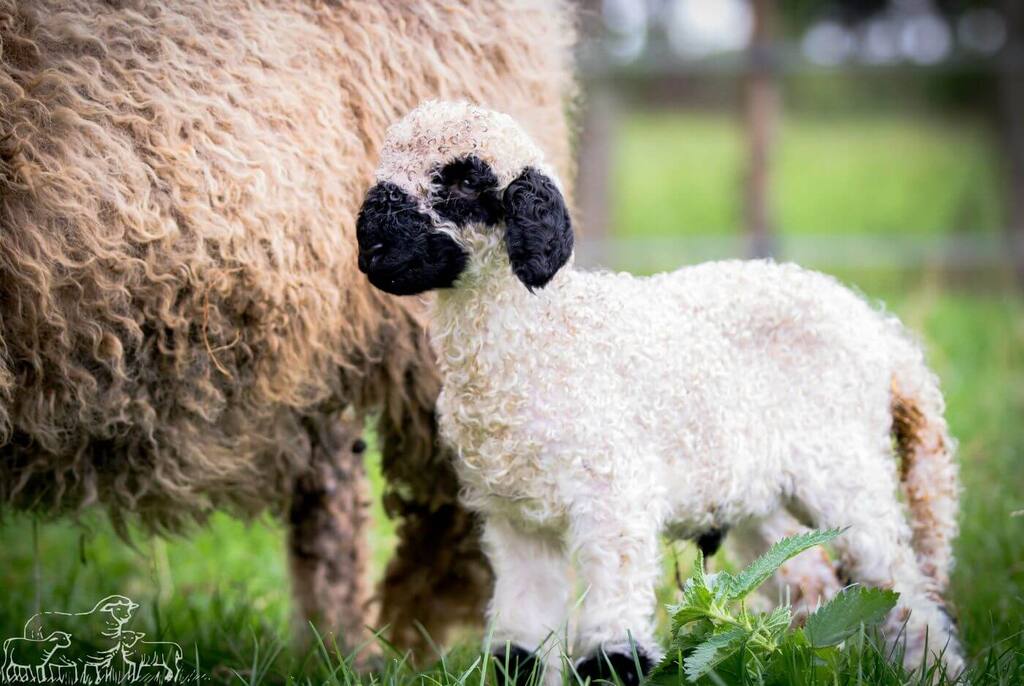
When breeding these sheep, you must choose carefully and take good care of them to preserve their unique characteristics and ensure the birth of strong offspring.
Breeding can be done naturally or through artificial insemination.
In many countries such as Australia or the United States, artificial insemination programs are more common, as they offer greater control over the genetic process.
These sheep should be bred starting at 18 to 24 months of age.
They are capable of breeding and reproducing throughout the year, as they are nonseasonal breeders.
A Valais Blacknose ewe can give birth to 1-2 lambs per year.
It is generally recommended to breed them only once a year for optimal health conditions.
They have a gestation period of 148 days, during which they require a nutritious diet.
After pregnancy, the ewe needs time to recover, and the newborn lambs require proper care too. This includes keeping them warm, ensuring they suckle and ingest sufficient colostrum, and maintaining good hygiene in their living area.
Lambs can be weaned at about 4 months old, but the appropriate timing depends on the development of the lamb’s rumen.
Their digestive system needs time to adjust from milk to grass or feed, so weaning them before 4 months might prevent proper digestion of pasture.
Health Issues
Valais Blacknose sheep, like all breeds of sheep, can be susceptible to various health issues.
Here are some common health issues that this sheep might face:
- Foot scald and foot rot
- Scrapie or Transmissible Spongiform Encephalopathies
- Parasites, like gastrointestinal worms
- Respiratory infections
- Pneumonia
- Clostridial Diseases
- Mineral Deficiencies
- External parasites like mites, lice, and ticks.
Vaccination
These sheep need to be vaccinated to maintain the immunity of your herd.
One recommended vaccine for these sheep is one that controls diseases such as lamb dysentery, pulpy kidney, struck, tetanus, braxy, blackleg, black disease, and clostridial metritis caused by bacteria.
Also, another one for bacteria such as Clostridium perfringens types B, C, and D, Clostridium septicum, Clostridium novyi, Clostridium chauvoei, and Clostridium tetani is suggested.
The initial vaccination schedule for lambs should be administered around 4 to 6 weeks of age, with a booster shot given 4 weeks after the first vaccine.
For adults, it is recommended to have a booster every 12 months.
In the case of breeding ewes, a booster is recommended 4 to 6 weeks before lambing.
Special Care
Compared with other sheep, Valais Blacknose needs special care.
Here are some things you can do to take care of them:
1.Always be on guard to prevent fly strikes. When the weather gets warm, put your fly strike plan into action.
Regularly inspect your sheep’s wool and skin. The areas most affected and needing frequent checks are under the sheep’s horns, hooves, and rear ends.
If you notice flies flying around a sheep, or if a sheep is limping, stomping, biting at its skin, losing wool, or if you see eggs or maggots, make sure to clean and treat the affected area right away.
2.Another essential plan you need is for worm control.
Sheep need to be dewormed, and remember that lambs are more susceptible to worms than older sheep. Signs that your sheep have worms include mucky rear ends.
A piece of advice is to regularly collect fecal samples from your herd and have them tested.
Deworming must be done regularly.
3.These sheep need special care when it comes to hooves.
Some common foot issues they can have are scald or interdigital dermatitis, toe granuloma, foot rot, shelly hoof, and white line abscesses.
You need to trim their hooves and regularly inspect their feet for issues. Signs that they may already have issues include limping or holding a hoof up.
If you see this, you need to remove the wool between the hooves and administer the treatment that the vet prescribes.
Why should you them?
The Valais Blacknose sheep is a good choice for individuals who are new to sheep farming or those who have a small farm or homestead.
When considering this sheep breed, there are two key factors to keep in mind at the outset: budget, special care and grooming.
While these sheep offer significant potential for generating profits, the initial costs can be quite high. Acquiring these sheep, which are quite expensive, is the first step.
Why are expensive?
Here are several reasons:
- They belong to a relatively rare and distinct sheep breed.
- Their appearance is uniquely charming and sets them apart.
- Breeding them requires careful genetic selection, time, and effort to maintain specific traits.
- Their well-being and the quality of their wool demand specialized care, leading to increased expenses for farmers.
A Valais Blacknose sheep can cost between $5.000 and $6.000.
If you’re interested in obtaining baby sheep, you’ll need to allocate a higher budget.
A Valais Blacknose lamb can cost between $15.000 and $17.000.
In case you lack a suitable environment like mountains or fields with good grazing, you must also budget for purchasing their food, which adds more to the overall expenses.
After starting, there are various ways to generate income. You can sell ewes, rams, and lambs. Additionally, you have the option to sell their meat and wool.
The wool from Valais Blacknose sheep can cost $6.00 for 1.5 oz.
Consider the various breeding programs that practice artificial insemination, you can also sell ram sperm or frozen embryos.
The price for one frozen embryo can range from $4.000 to $8.000.
With their cuteness and fluffiness, you can even create an agrotourism business, targeting parents with kids who are eager to observe and explore animals.
A and D
Advantages
- These are dual-purpose sheep.
- They have a good lifespan.
- Their wool is valuable for various crafts.
- They offer substantial meat production.
- They are a hardy breed.
- They are nonseasonal breeders.
Disadvantages
- They need special care.
- Their wool requires regular baths and combing.
- They are prone to foot problems.
- They are expensive and rare.
Do you have any experience with the topic discussed here?
Would you like to improve the information shared and contribute your practical knowledge on the subject?
Your real-world experience as a farmer or rancher could greatly benefit other members, and the community would deeply appreciate your contribution.


